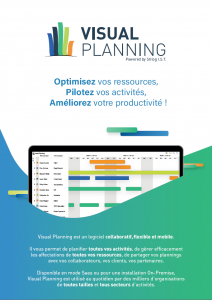Understanding the distinction between human resource management (HRM) and human capital management (HCM) is vital for fostering employee engagement, satisfaction, and overall business success. Using employee scheduling software, which companies can utilize from Visual Planning, can provide you with tools from both sectors to move your team members to success. In this article, we’ll explore the core elements of human capital vs. human resources, their nuances, and how they can contribute to your organization’s strategic growth and prosperity. By the end, you should have more information on how tools from Visual Planning can work for you.
Understanding Human Resource Management

HRM is a multifaceted discipline that focuses on managing the employees within an organization. It encompasses various functions and activities aimed at attracting, developing, and retaining a skilled workforce. One key characteristic is its emphasis on identifying and implementing procedures and business strategies to achieve desired outcomes. This includes assessing the company’s needs, determining appropriate training techniques, and tracking the success of training programs.
For instance, professionals under this discipline create compelling job descriptions that accurately reflect the skills and qualifications needed for a particular role. They also utilize various recruitment channels, such as online job portals, social media platforms, and professional networks, to reach a diverse pool of candidates. In addition to attracting talent, proper management ensures that the recruiting process is fair, consistent, and compliant with regulations. HR professionals conduct candidate screenings, facilitate interviews, and administer pre-employment assessments to evaluate the candidates’ suitability for the role. They also collaborate with hiring managers and teams to ensure a comprehensive and effective selection process.
Exploring Human Capital Management

On the other hand, HCM is a broader concept that encompasses HRM but takes a more holistic approach to talent management. This strategy focuses on leveraging the value and potential of employees as valuable assets. It goes beyond traditional HR functions and extends to talent acquisition, performance management, and employee development.
This concept recognizes that workers are valuable investments, and their skills and capabilities help everyone gain a competitive edge. This method involves assessing the workforce’s existing strengths and areas for improvement, as well as identifying future talent needs. A key focus of this approach is strategic talent acquisition, which ensures that the right people are hired and that recruitment efforts align with the company’s long-term goals. Moreover, it places significant emphasis on employee development, understanding that continuous learning and growth are essential for both individual and organizational success.
For example, imagine a technology company that wants to expand its business processes and capabilities in artificial intelligence (AI). HCM plays a crucial role in this scenario by assessing the existing workforce’s skills and identifying areas for improvement. The company conducts a thorough evaluation to determine the AI-related competencies it currently possesses and identifies any gaps in its talent pool. Based on the assessment, the team develops a strategic talent acquisition plan to fill these skill gaps. The team then identifies the specific AI-related skills required, which may include machine learning, data analysis, and algorithm development. The recruitment efforts then focus on attracting candidates with a strong background in AI and relevant experience.
What Is the Difference Between HCM and HRM?

You may be wondering, is human capital a resource? What are their key differences? HCM and HRM are two distinct approaches to managing workforces. While both focus on effectively utilizing human resources, they differ in their strategic perspectives and areas of emphasis.
The former takes a more holistic approach by recognizing employees as valuable assets and aligning HR practices with overall business objectives. It goes beyond traditional human resource functions and encompasses talent management, workforce planning, and development. This method places a strong emphasis on identifying the company’s talent needs both in the present and future, considering factors such as skills, competencies, and cultural fit. It takes a strategic outlook to attract, retain, and develop employees, viewing them as critical contributors to long-term success.
On the other hand, HRM is more focused on implementing strategies to meet the talent needs the HR planning process identifies. It primarily concentrates on day-to-day HR functions, such as recruitment, training, performance management, and employee relations. Additionally, this method ensures that the organization has the right people in the right positions by employing effective hiring practices, providing training and development opportunities, and managing employee performance. While strategic management contributes to meeting talent needs, it generally operates within a narrower scope compared to the comprehensive nature of HCM.
Importance of Strategic Human Capital and Resource Management for Organizational Success

Using HCM and HRM strategically is vital for achieving organizational success. Both disciplines recognize the critical role that employees play in driving business growth and emphasize the importance of balancing the needs of workers with the goals and initiatives of the organization.
First and foremost, using both of these methods effectively contribute to creating a work environment where employees feel respected, valued, and taken care of. HRM practices ensure fair compensation, benefits, and policies that promote work-life balance and employee well-being. On the other hand, HCM focuses on recognizing employees as valuable assets and aligning their skills and talents with strategic objectives.
Simultaneously, the two strategies drive success by aligning employee efforts with company goals and initiatives. HRM identifies the training and development needs of individual employees, providing them with the tools and resources to enhance their skills and contribute to objectives. Meanwhile, HCM takes a broader perspective by aligning human resources strategies with strategic business goals, ensuring that the workforce is equipped to support the company’s long-term vision. By aligning the efforts of employees with the organization’s strategic direction, the two methods help foster a cohesive and high-performing workforce that actively works toward advancing goals.
Empower Your Teams With Visual Planning

Understanding the difference between human capital management vs. human resource management is crucial for companies seeking to optimize their workforce and drive success. To further explore how software applications and solutions like Visual Planning can streamline and improve HR processes, and to witness firsthand the benefits it offers, reach out today to book a demo. Discover how Visual Planning can empower your company with efficient and effective human capital and resource management.
Visual Planning is available on premise or in the cloud. Find out more about all Visual Planning features here, or read our case studies to understand how we are helping many companies to leverage their inner strengths.
Communicator Journalist with an Organizational Communication master degree specialized in Digital Communication from Jean Moulin Lyon 3 University. Passionate about new technologies, social medias, marketing and cooking.



